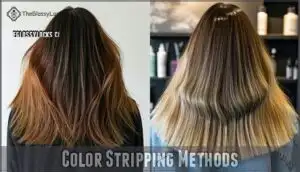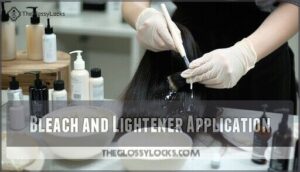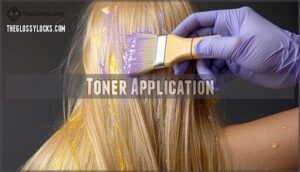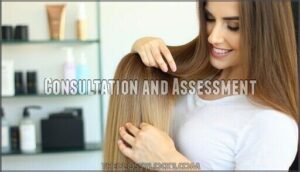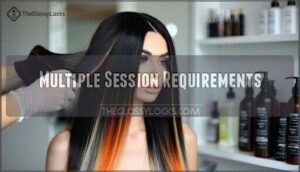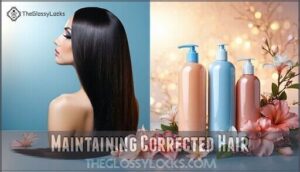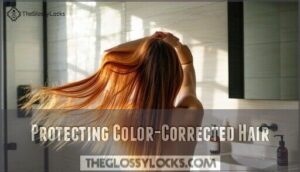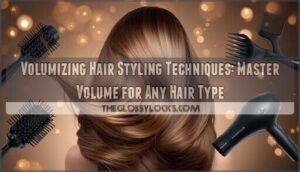This site is supported by our readers. We may earn a commission, at no cost to you, if you purchase through links.
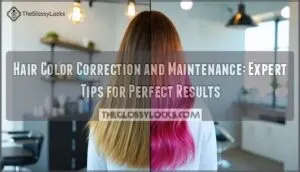
The key is working gradually – rushing the process will fry your hair faster than you can say "box dye disaster." Professional consultation helps determine whether you need lightening, pre-pigmentation, or neutralizing treatments.
Once corrected, you’ll maintain results with color-safe products, deep conditioning treatments, and heat protection. The road to color recovery requires patience, but understanding the right techniques and timing makes all the difference.
Table Of Contents
- Key Takeaways
- Hair Color Correction
- Color Correction Techniques
- Hair Color Correction Process
- Maintaining Corrected Hair
- Protecting Color-Corrected Hair
- Frequently Asked Questions (FAQs)
- What is the average cost of a color correction?
- How do you know if your hair needs color correction?
- What do they do for color correction?
- How do you maintain color treated hair?
- Can I color correct my own hair at home?
- How often should I touch up my roots?
- Will color correction work on damaged hair?
- Can I get color correction with hair extensions?
- Is color correction safe for pregnant women?
- Can hair color correction damage my hair permanently?
- Conclusion
Key Takeaways
- Work gradually through multiple sessions – Don’t rush color correction, as it typically requires 2-4 appointments spaced weeks apart to prevent severe hair damage and achieve your desired results safely.
- Use color-safe products religiously – Invest in sulfate-free shampoos, pH-balanced conditioners, and deep conditioning treatments weekly to protect your investment and prevent premature fading.
- Protect from heat and UV damage – Always apply heat protectants before styling, limit high-temperature tools, and use UV protection sprays or hats to shield your corrected color from sun damage.
- Trust professional expertise for complex corrections – While you can maintain corrected hair at home, major color disasters and chemical processes require professional colorists who understand complementary colors and damage prevention techniques.
Hair Color Correction
Hair color correction fixes unwanted tones, uneven shades, and color mishaps that leave you disappointed with your hair.
Whether you’re dealing with brassy blondes, patchy DIY disasters, or salon results that missed the mark, professional correction techniques can restore your hair to the shade you actually wanted.
Definition and Purpose
Through expert intervention, hair color correction defined as a specialized treatment that addresses imperfections in your hair’s tone and shade.
Whether you’re fixing hair color disasters or achieving harmony after DIY mishaps, this purpose explained process transforms uneven, brassy, or unwanted hues into balanced results.
Color correction tips focus on restoring your hair’s natural beauty while maintaining hair color integrity for lasting satisfaction, which is crucial for achieving harmony and ensuring natural beauty.
Common Reasons for Correction
You’ve probably experienced one of these hair color nightmares: brassiness causes that orange glow in blonde hair, uneven color from overlapping hues, or DIY disasters leaving patchy results.
Color fading creates inconsistent tones, while box dye creates unwanted hair color results with metallic buildup.
These hair color mistakes happen when previous treatments clash or fade unpredictably, creating uneven tones that scream "help me! Skilled colorists understand complementary color principles to correct these issues, applying complementary color principles to achieve the desired result.
Box Dye Consequences
Box dye disasters strike when metallic salts and harsh chemicals create uneven lifting and unpredictable results.
These DIY hair color mistakes cause serious hair damage and stubborn color build-up that resists professional correction.
Your hair becomes a chemistry experiment gone wrong, requiring extensive hair color correction to fix unwanted hair color results and restore healthy-looking locks with professional correction.
Color Correction Techniques
When your hair color goes wrong, you’ll need specific techniques to fix the damage and get back on track.
From gentle color stripping to precise toner application, these methods will restore your hair’s health while achieving your desired shade, using techniques such as gentle color stripping to precise application to get the desired results.
Color Stripping Methods
Color stripping breaks the bonds holding artificial dye in your hair.
Liberation starts when you break those stubborn dye molecules free from your hair shaft.
Sulfite-based color removers work gentlest, while persulfate formulas tackle stubborn box dyes more aggressively.
Developer selection matters—choose 10-volume for gentle lifting or 20-volume for resistant color.
Product choice depends on your hair’s history and damage level.
Application techniques require even saturation and careful timing.
Some people buy sulfite color stripper online.
Always follow with deep conditioning for damage control and proper post-strip care, ensuring your hair receives the necessary treatment after color stripping.
Bleach and Lightener Application
When color stripping isn’t enough, bleach and lightener become your heavy hitters.
Powdered bleach delivers stronger lift than cream formulations, achieving 7-9 levels but requiring careful damage control.
Apply in ¼-inch sections using proper application techniques to prevent patchiness.
Oil-based lighteners offer gentler 3-5 level lift for fine hair.
Many stylists buy powdered hair bleach online.
Always incorporate bond-building products during hair lightening to minimize structural damage and prepare for toning aftercare.
Balayage and Highlights
When bleach isn’t enough, balayage techniques and highlight placement create dimensional color that fixes uneven tones.
These blending strategies let you selectively lighten problem areas while maintaining natural-looking results.
Strategic highlight placement targets brassiness without over-processing your entire head.
Remember, you’ll still need toning highlights afterward to neutralize unwanted warmth and perfect your corrected color.
Toner Application
Most professional colorists agree that toner application is the game-changer for achieving salon-quality results. This vital step neutralizes brassiness and creates the perfect shade you’re after.
Professional toner application transforms brassy disasters into salon-perfect shades that actually match your vision.
- Violet-based toner counteracts yellow undertones in blonde hair
- Blue-based toner eliminates orange and brassy hues effectively
- Application techniques require damp hair and even distribution for best results
- Toning treatment typically processes for 5-20 minutes depending on porosity
- DIY toners like purple shampoo help maintain results between salon visits. Toner basically deposits semi-permanent color onto the hair shaft.
Hair Color Correction Process
Getting your hair color corrected isn’t something you rush through—it’s a careful process that requires professional expertise and realistic expectations.
You’ll likely need multiple appointments spaced weeks apart, especially if you’re fixing major color disasters or going from dark to light shades.
Consultation and Assessment
Before diving into specific techniques, you’ll need a thorough consultation and assessment with your colorist.
They’ll examine your hair history, current hair condition, and hair texture while discussing your desired outcome.
This conversation helps set realistic expectations and determines if a patch test is necessary.
Your colorist will assess previous treatments, damage levels, and natural undertones to create a personalized correction plan.
A key step involves understanding complementary colors to neutralize unwanted tones, which is crucial for a successful hair color correction.
Multiple Session Requirements
Most corrections require multiple sessions because dark artificial pigments resist single-process removal.
You’ll need realistic expectations about gradual changes to minimize hair damage while preserving hair integrity throughout the corrective process.
- Pigment buildup from box dyes creates stubborn color bands requiring 2-4 sessions
- Damage minimization through spaced appointments protects your hair’s structural foundation
- Cost considerations multiply with each session, but patience prevents expensive hair disasters
Time and Patience Factors
Complex corrective processes require realistic expectations about session length and gradual changes.
You’ll need patience as your colorist works through multiple appointments, sometimes spanning weeks.
Each hair treatment history demands a unique timeline—rushing leads to damage prevention issues.
Embrace this long-term commitment; gradual correction protects your hair’s integrity while achieving stunning results.
Maintaining Corrected Hair
After spending hours perfecting your color correction, you’ll want to protect that investment with the right maintenance routine.
Your newly corrected hair needs special care to stay vibrant and healthy, so choosing the right products and habits makes all the difference.
Color-Safe Shampoo and Conditioner
Protecting your color-treated hair starts with understanding what you’re washing it with—sulfate alternatives like sodium cocoyl isethionate cleanse gently without stripping.
Smart ingredient analysis reveals pH balance matters more than fancy marketing claims, while hydration focus should guide your product selection over flashy packaging promises.
Many people prefer products for treated hair to maintain vibrant color.
- Sulfate-free formulas preserve your investment by preventing premature color fade
- pH-balanced products (4.5-5.5) seal cuticles and lock in pigments effectively
- Colorsafe conditioner with proteins rebuilds bonds damaged during correction processes
- Brand comparisons between Pureology and drugstore options reveal similar protective ingredients
Deep Conditioning Importance
Deep conditioning treatments deliver the Hydration Boost your color-corrected hair craves, transforming brittle strands into silky perfection.
Weekly sessions provide essential Damage Repair and Elasticity Improvement, ensuring your investment stays vibrant longer.
Think of it as a spa day for your locks—your hair condition dramatically improves while Color Retention increases.
Plus, you’ll notice superior Frizz Control and healthier hair health overall.
Many find that regular deep conditioning is key to maintaining hair health.
Limiting Heat Styling
After your color correction journey, heat styling becomes your hair’s biggest enemy.
Use heat protectants religiously and embrace air drying whenever possible—your color treated hair will thank you.
When you must style, choose low heat settings and explore styling alternatives like braids or curls.
This hydration balance keeps your color safe shampoo and color safe conditioner working effectively with proper heat protection.
Protecting Color-Corrected Hair
Once you’ve invested time and money in color correction, protecting your hair becomes essential to maintain those beautiful results.
The right protection strategies help prevent fading, damage, and the need for frequent touch-ups, which is crucial for maintaining the beautiful results.
Minimizing Sun Damage
Summer’s blazing rays are your color-treated hair’s worst enemy, causing rapid color fading and dryness.
Shield your locks with UV protection sprays containing sunscreen for hair, and maintain hydration balance through color safe shampoo and conditioner.
Consider protective styles like braids or scarves during peak sun hours to preserve your investment in professional hair color maintenance.
Regular Trims and Maintenance
Scheduling hair trims every six to eight weeks keeps your color-corrected hair looking fresh and healthy.
Regular professional trimming prevents split end removal issues while supporting your hair growth cycle and shape retention.
This consistent maintenance routine helps with avoiding damage that can make your beautiful new color look dull or uneven.
Protecting Hair From UV Rays
Sun’s rays can fade your freshly corrected color faster than you’d think.
Apply sunscreen for hair before heading outdoors – these UV protection products prevent color fade prevention by blocking harmful rays.
Wide-brimmed hats create stylish hat hair styles while shielding strands.
Hydration and sun don’t mix well, so deep condition weekly to combat UV hair damage and maintain your investment by using products that provide UV protection.
Using Top Coat for Shine and Protection
Something magical happens when you apply a top coat to freshly corrected hair—it’s like adding a protective shield that locks in your investment.
This hair gloss treatment enhances shine while providing essential UV protection and extending color longevity.
Here’s how to maximize topcoat benefits:
- Select colorsafe products with pH-balancing formulas for ideal color maintenance
- Apply mid-length to ends using proper application techniques, avoiding roots
- Heat-activate at low temperatures to enhance product adherence and hair health
- Reapply every 2-4 weeks to maintain protection and glossy finish
Your corrected color deserves this final step for lasting results.
Frequently Asked Questions (FAQs)
What is the average cost of a color correction?
Prepare your wallet for a significant investment – color correction costs typically range from $200 to $800, depending on your hair’s damage level and salon location.
You’ll pay more for complex fixes requiring multiple sessions.
How do you know if your hair needs color correction?
You’ll know your hair needs color correction if you notice uneven tones, unwanted brassiness, patchy color, fading that’s left you with muddy hues.
Or DIY disasters that didn’t turn out as expected, which can be considered a DIY disaster.
What do they do for color correction?
Like a skilled artist repairing a damaged masterpiece, colorists use color removal, bleaching, toning, and precision techniques to strip unwanted pigments and rebuild your hair’s shade systematically.
How do you maintain color treated hair?
Use sulfate-free shampoo, deep condition weekly, and minimize heat styling. Wait 48 hours before washing, protect from sun exposure, and schedule regular trims every 6-8 weeks to maintain your color’s vibrancy.
Can I color correct my own hair at home?
While you can attempt color correction at home, it’s risky and often leads to more damage.
Professional colorists have expertise in complex chemical processes that home products lack, ensuring safer results for your hair’s health.
How often should I touch up my roots?
Timing’s everything! You’ll typically need root touch-ups every 4-6 weeks, depending on your hair’s growth rate and color contrast. Faster-growing hair or dramatic color differences may require more frequent visits.
Will color correction work on damaged hair?
Color correction can work on damaged hair, but you’ll need extra care and possibly multiple sessions.
Your stylist will assess your hair’s condition first and use bond-building treatments to protect it during the process.
Can I get color correction with hair extensions?
Like ancient alchemists transforming base metals, you can absolutely get color correction with extensions.
However, synthetic extensions won’t take color, so you’ll need human hair extensions that match your natural hair’s processing ability for seamless results.
Is color correction safe for pregnant women?
You’ll want to avoid color correction during pregnancy since chemicals can be absorbed through your scalp. Most professionals recommend waiting until after breastfeeding for safety.
Can hair color correction damage my hair permanently?
Professional hair color correction, when done properly, won’t permanently damage your hair.
However, improper techniques or over-processing can cause lasting harm.
Trust skilled colorists who use bond-building treatments and assess your hair’s condition first.
Conclusion
Sometimes the universe has perfect timing – just when you think your hair disaster can’t get worse, you discover hair color correction and maintenance techniques that actually work.
Remember, successful correction isn’t about speed; it’s about strategic patience and proper technique.
Whether you’re dealing with brassiness, uneven color, or complete color chaos, the right approach transforms damaged hair into your dream shade.
Invest in quality products, trust the process, and don’t skip the deep conditioning treatments. Your hair will thank you later.
- https://us.wella.professionalstore.com/en-US/blog/hair-color/how-to-do-hair-color-correction
- https://www.madison-reed.com/blog/hair-color-correction
- https://www.salonhaze.com/blogs/why-hair-color-fades
- https://www.livingproof.com/blogs/hair-101/colored-hair-tips
- https://malibuc.com/blogs/blog/5-tips-to-maintain-color-treated-hair

